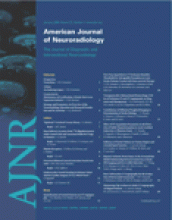Abstract
BACKGROUND AND PURPOSE: The aim of this study was to evaluate 2D-digital subtraction angiographic (DSA) and 3D-time-of-flight (TOF) MR imaging in assessment of aneurysmal residue by using a pulsating silicon aneurysm model. For each imaging system, we studied intra- and interobserver reproducibility and the agreement between interpretations and reference measurements. We also examined how each imaging technique affected the operator’s therapeutic decision.
METHODS: Two silicon aneurysm models depicting subarachnoidal aneurysms were used, one with a wide neck and one with a narrow neck. Each aneurysm model was placed in series on a pulsed flow circuit and was filled with Guglielmi detachable coils to simulate a clinical case. Each aneurysm was then gradually filled with silicon gel in increments of 10%, up to 100% to simulate different levels of occlusion (residual neck or dog ear, partial, complete) at each filling level. For each level of filling, we performed conventional 2D-DSA and 3D-TOF MR imaging. We submitted the images for examination by 2 senior medical staff with 2 readings per image. A combined reading of the 2 images was submitted to each expert to determine whether the 2 examinations were complementary.
RESULTS: The 2D-DSA analysis showed good reproducibility (k = 0.8 and k = 0.57) and agreement (k = 0.71) in describing “complete” treatments. The distinction between a “residual neck” and “partial treatment,” however, was not reliable. The 2D-DSA provided a good description of the coil and silicon protrusion into the parent artery. The 3D-TOF analysis of the residual aneurysm, however, was not reproducible, though it was more effective than the 2D-DSA in evaluation of partially wide-necked aneurysms (k = 0.68 MR imaging vs k = 0.041 2D-DSA; P = .018). At the same filling level, the 2D-DSA analysis indicated repeat treatment more often than 3D-TOF analysis (P = .059).
CONCLUSION: The 2D-DSA remains the gold standard, but MR imaging is more effective in evaluating a “partial treatment.” The 2D-DSA analysis indicated repeat treatment more often than the 3D-TOF for the same occlusion level. The distinction between “partial treatment” and a “residual neck” was not reliable with either method of evaluation.
- Copyright © American Society of Neuroradiology












